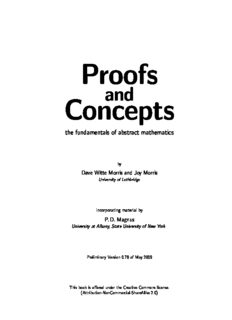
Proofs and concepts: the fundamentals of abstract mathematics PDF
Preview Proofs and concepts: the fundamentals of abstract mathematics
Proofs and Concepts the fundamentals of abstract mathematics by Dave Witte Morris and Joy Morris University of Lethbridge incorporating material by P.D. Magnus University at Albany, State University of New York Preliminary Version 0.78 of May 2009 This book is offered under the Creative Commons license. (Attribution-NonCommercial-ShareAlike 2.0) The presentation of logic in this textbook is adapted from forallx An Introduction to Formal Logic P.D. Magnus University at Albany, State University of New York The most recent version of forallx is available on-line at http://www.fecundity.com/logic We thank Professor Magnus for making forallx freely available, and for authorizing derivative works such as this one. He was not involved in the preparation of this manuscript, so he is not responsible for any errors or other shortcomings. Please send comments and corrections to: [email protected] or [email protected] (cid:13)c 2006–2009 by Dave Witte Morris and Joy Morris. Some rights reserved. Portions (cid:13)c 2005–2006 by P.D.Magnus. Some rights reserved. Brief excerpts are quoted (with attribution) from copyrighted works of various authors. You are free to copy this book, to distribute it, to display it, and to make derivative works, under the following conditions: (1) Attribution. You must give the original author credit. (2) Noncommercial. You may not use this work for commercial purposes. (3) Share Alike. If you alter, transform, or build upon this work, you may distribute the resulting work only under a license identical to this one. — For any reuse or distribution, you must make clear to others the license terms of this work. Any of these conditionscanbewaivedifyougetpermissionfromthecopyrightholder. Yourfairuseandotherrights are in no way affected by the above. — This is a human-readable summary of the full license, which is available on-line at http://creativecommons.org/licenses/by-nc-sa/2.0/legalcode to Harmony Contents Part I. Introduction to Logic and Proofs Chapter 1. What is Logic? 3 §1A. Assertions and deductions ....................................................3 §1B. Two ways that deductions can go wrong --------------------------------- 4 §1C. Deductive validity............................................................5 §1D. Other logical notions -------------------------------------------------- 6 §1D.1. Truth-values .............................................................6 §1D.2. Logical truth ----------------------------------------------------- 6 §1D.3. Logical equivalence.......................................................7 §1E. Logic puzzles --------------------------------------------------------- 8 Summary ...........................................................................9 Chapter 2. Propositional Logic 11 §2A. Using letters to symbolize assertions.........................................11 §2B. Connectives --------------------------------------------------------- 12 §2B.1. Not (¬) .................................................................13 §2B.2. And (&)--------------------------------------------------------- 14 §2B.3. Or (∨) ..................................................................16 §2B.4. Implies (⇒)------------------------------------------------------ 18 §2B.5. Iff (⇔) ..................................................................21 Summary ----------------------------------------------------------------- 22 Chapter 3. Basic Theorems of Propositional Logic 23 §3A. Calculating the truth-value of an assertion...................................23 §3B. Identifying tautologies, contradictions, and contingent sentences------------ 25 §3C. Logical equivalence..........................................................26 §3D. Converse and contrapositive ------------------------------------------- 30 §3E. Some valid deductions .......................................................31 §3F. Counterexamples ----------------------------------------------------- 34 Summary ..........................................................................35 i ii Chapter 4. Two-Column Proofs 37 §4A. First example of a two-column proof.........................................37 §4B. Hypotheses and theorems in two-column proofs -------------------------- 40 §4C. Subproofs for ⇒-introduction................................................43 §4D. Proof by contradiction ------------------------------------------------ 49 §4E. Proof strategies .............................................................53 §4F. What is a proof? ----------------------------------------------------- 54 Summary ..........................................................................56 Part II. Sets and First-Order Logic Chapter 5. Sets, Subsets, and Predicates 59 §5A. Propositional Logic is not enough ...........................................59 §5B. Sets and their elements ----------------------------------------------- 60 §5C. Subsets .....................................................................64 §5D. Predicates ---------------------------------------------------------- 65 §5E. Using predicates to specify subsets...........................................68 Summary ----------------------------------------------------------------- 70 Chapter 6. Operations on Sets 71 §6A. Union and intersection ......................................................71 §6B. Set difference and complement ----------------------------------------- 73 §6C. Cartesian product ...........................................................74 §6D. Disjoint sets --------------------------------------------------------- 75 §6E. The power set ...............................................................76 Summary ----------------------------------------------------------------- 78 Chapter 7. First-Order Logic 79 §7A. Quantifiers..................................................................79 §7B. Translating to First-Order Logic --------------------------------------- 81 §7C. Multiple quantifiers .........................................................84 §7D. Negations ----------------------------------------------------------- 85 §7E. Equality ....................................................................88 §7F. Vacuous truth ------------------------------------------------------- 89 §7G. Uniqueness .................................................................89 §7H. Bound variables------------------------------------------------------ 90 §7I. Counterexamples in First-Order Logic ........................................91 Summary ----------------------------------------------------------------- 93 iii Chapter 8. Quantifier Proofs 95 §8A. The introduction and elimination rules for quantifiers ........................95 §8A.1. ∃-introduction --------------------------------------------------- 95 §8A.2. ∃-elimination............................................................96 §8A.3. ∀-elimination ---------------------------------------------------- 97 §8A.4. ∀-introduction ..........................................................98 §8A.5. Proof strategies revisited ----------------------------------------- 101 §8B. Some proofs about sets .....................................................101 §8C. Theorems, Propositions, Corollaries, and Lemmas ----------------------- 104 Summary .........................................................................105 Part III. Functions Chapter 9. Functions 109 §9A. Informal introduction to functions ..........................................109 §9B. Official definition---------------------------------------------------- 112 Summary .........................................................................115 Chapter 10. One-to-One Functions 117 Summary .........................................................................121 Chapter 11. Onto Functions 123 §11A. Concept and definition ....................................................123 §11B. How to prove that a function is onto---------------------------------- 124 §11C. Image and pre-image ......................................................126 Summary ---------------------------------------------------------------- 127 Chapter 12. Bijections 129 Summary .........................................................................132 Chapter 13. Inverse Functions 133 Summary .........................................................................135 Chapter 14. Composition of Functions 137 Summary .........................................................................140 iv Part IV. Other Fundamental Concepts Chapter 15. Cardinality 143 §15A. Definition and basic properties ............................................143 §15B. The Pigeonhole Principle-------------------------------------------- 146 §15C. Cardinality of a union.....................................................148 §15D. Hotel Infinity and the cardinality of infinite sets ----------------------- 149 §15E. Countable sets ............................................................152 §15F. Uncountable sets --------------------------------------------------- 156 §15F.1. The reals are uncountable .............................................156 §15F.2. The cardinality of power sets ------------------------------------- 157 §15F.3. Examples of irrational numbers........................................157 Summary ---------------------------------------------------------------- 159 Chapter 16. Proof by Induction 161 §16A. The Principle of Mathematical Induction ..................................161 §16B. Proofs about sets -------------------------------------------------- 165 §16C. Other versions of Induction ...............................................168 Summary ---------------------------------------------------------------- 170 Chapter 17. Divisibility and Congruence 171 §17A. Divisibility................................................................171 §17B. Congruence modulo n ---------------------------------------------- 173 Summary .........................................................................176 Chapter 18. Equivalence Relations 177 §18A. Binary relations...........................................................177 §18B. Definition and basic properties of equivalence relations ------------------ 180 §18C. Equivalence classes........................................................182 §18D. Modular arithmetic ------------------------------------------------ 183 §18D.1. The integers modulo 3 ................................................183 §18D.2. The integers modulo n ------------------------------------------ 184 §18E. Functions need to be well defined..........................................185 §18F. Partitions --------------------------------------------------------- 185 Summary .........................................................................187 Part V. Topics Chapter 19. Elementary Graph Theory 191 §19A. Basic definitions ..........................................................191 §19B. Isomorphic graphs-------------------------------------------------- 195 §19C. Digraphs..................................................................196 §19D. Sum of the valences ------------------------------------------------ 198 Summary .........................................................................201 v Chapter 20. Isomorphisms 203 §20A. Definition and examples...................................................203 §20B. Proofs that isomorphisms preserve graph-theoretic properties ------------ 204 Summary .........................................................................207 Index of Definitions 209
